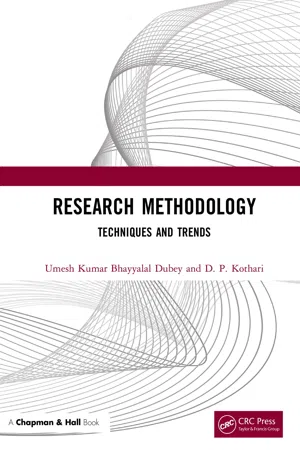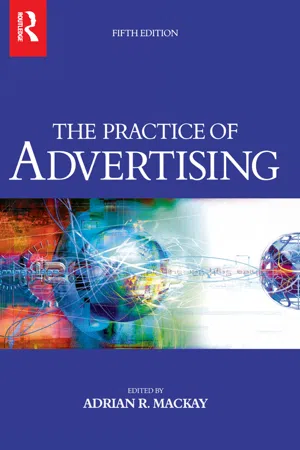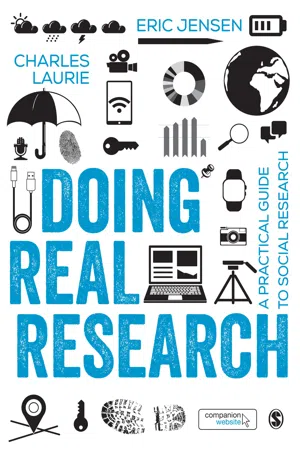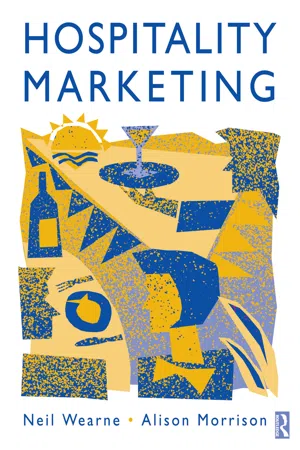Marketing
Survey Research
Survey research in marketing involves collecting data from a sample of individuals to gain insights into their preferences, behaviors, and opinions. This method uses structured questionnaires or interviews to gather quantitative and qualitative data, which can be analyzed to inform marketing strategies, product development, and customer satisfaction initiatives.
Written by Perlego with AI-assistance
Related key terms
Related key terms
1 of 4
Related key terms
1 of 3
11 Key excerpts on "Survey Research"
- eBook - ePub
Research Methodology
Techniques and Trends
- Umesh Kumar B Dubey, D P Kothari(Authors)
- 2022(Publication Date)
- Chapman and Hall/CRC(Publisher)
8 Survey ResearchDOI: 10.1201/9781315167138-88.1 Introduction to Survey Research
Survey Research is one of the most relevant techniques basically used for collecting data. This method involves any measurement procedures that prominently include asking questions from respondents or the subjects selected for the research study. The term “survey” can be defined as a process that may involve an investigation or an examination or assessment in the form of a short paper and pencil feedback form to an intensive one-on-one in-depth interview. The method tries to gather data about people, their thoughts and behaviors, with the help of the questionnaire or other statistical tools.A researcher should at first explore all sources of secondary data and verify the possibility of their usage for the research at hand. But it may so happen that after a point, these secondary data, for making further marketing decisions, might prove to be inadequate or of no use to the researcher. In such cases, the researcher has to go in for primary data research employing Survey Research method.A survey cannot measure the behavior of people, but can trace a certain behavior to the perceptions, feelings, attitudes, beliefs, and other personal characteristics of the respondent.8.2 Concept and Meaning of Survey Research
The method of Survey Research does not involve any observation under controlled conditions, hence it is a nonexperimental. Descriptive research used for studying of large sample is one of the quantitative method. Population is referred to as the universe of a study, which can be defined as a collection of people or object, which possesses at least one common characteristic. - Bonita Kolb(Author)
- 2008(Publication Date)
- Routledge(Publisher)
Use of Survey ResearchSurvey Research can be used to answer questions about any aspect of the marketing mix, including the customers and their behaviour. In addition survey questions can be asked about the product, price, place and promotion (see Table 10.1 ).Customers: One of the most fundamental uses of Survey Research is to learn more about the composition of the organization’s current customers including both demographic facts and psychographic interests (Corder, 2006). Everyone is familiar with the survey form that is received from an organization through the mail, in person or via email that asks about the customer’s age, gender, income, education level and activity preferences.Product: Another use of Survey Research would be to learn more about the product preferences of either current or potential customers. The survey form may be designed to ask the customer the brand names of the products they purchase. Or, the form may ask general questions about the benefits customers prefer in a product. Since a product consists both of the actual product or service and also the extended product, the survey might ask what additional products or services the customer would like to see packaged with the product. For example, the survey form might ask what type of food should be served at the snack bar of a theatre or ask if follow up calls from health care providers would be useful for the customer.Other product issues that could be researched using a survey form include the purchase habits of consumers. A questionnaire could be designed to ask how often the product is purchased, the amount purchased and who does the purchasing. For example, an organization that provides art classes for teenagers would want to know if the teens attend classes regularly or infrequently. The organization would also want to know if they attend one or many classes and if it is the parents or teens that make the decision to attend.- eBook - ePub
Foundations for Research
Methods of Inquiry in Education and the Social Sciences
- Kathleen B. deMarrais, Stephen D. Lapan, Kathleen B. deMarrais, Stephen D. Lapan(Authors)
- 2003(Publication Date)
- Routledge(Publisher)
Survey Research is not a design, per se; instead, surveys are more commonly considered the medium used for data collection. However, most Survey Research falls within the framework of nonexperimental or correlational research designs in which no independent variable is experimentally manipulated. When used in this context, information gathered from surveys is typically used either for purely descriptive purposes or for examining relationships between variables. Though not as common, surveys can also be included as part of an experimental study, for example, where participants are surveyed about attitudes or opinions following some type of experimental intervention. Surveys can also be used as a method of data collection in qualitative research, although they tend to be employed less frequently for this purpose, given the generally prescriptive structure of survey questions. In addition, when surveys are used in qualitative studies, they usually comprise only one of many sources of data, whereas in quantitative survey studies, the survey is the primary, if not sole, method of data collection. Often subsumed within the definition of Survey Research is the requirement of some type of rigorous sampling procedure (Miller, 1983). Some authors even make the distinction between a survey as data collected from a sample and a census as data based on all units of a given population (Jolliffe, 1986; Schwarz, Groves, & Schuman, 1998).Survey Research can also be defined in terms of the type of information gathered or the purposes for which the information is collected. Alreck and Settle (1995) contended that the reasons for conducting surveys include influencing a selected audience, modifying a service or product, and understanding or predicting human behavior. Rea and Parker (1997) added understanding people’s interests and concerns as motives for using surveys, with data reflecting the descriptive, behavioral, or preferential characteristics of respondents. Weisberg and Bowen (1977) categorized the types of information gathered from surveys into opinions, attitudes, and facts. - Bonita Kolb(Author)
- 2020(Publication Date)
- Routledge(Publisher)
Create visuals: Many people find it easier to understand numbers when they are in charts or graphs. They also provide a more dramatic effect if data is widely skewed in one direction.Determine action: If all that is done with survey results is to analyze and report the findings, the survey has been a waste of time and money. Instead action based on the findings should be recommended.Stillwagon 2017QUESTION TO CONSIDER: What preconceived ideas might I bring when analyzing the data from a survey on why consumers purchase our product?A survey is frequently used to answer factual questions. Because the questions will focus on a description of consumers and quantify their behavior it is often referred to as descriptive research. A survey asks factual questions that provide answers on who, what, where, and how. For example, a research question on who buys the product can be answered by writing survey questions that ask about age, gender, and income level. A research question on what they prefer to buy can be answered by writing survey questions that ask customers to rank different products that are available. In addition, where they buy can be answered with a question that distinguishes between website purchases, craft fairs, or different store locations.Survey method—the method everybody knows
When many people think of research, it is probably a survey that first comes to mind. A survey is a research method where all participants are asked the same questions with predetermined answers. While most survey questions will ask research subjects to choose from a list of possible answers, they can also include open-ended questions that allow respondents to answer in their own words.While a survey can be conducted using paper forms distributed at retail stores or at an event, the increasing popularity of customer surveys is because they can be simple to administer online. All that is necessary are customer email addresses, which can be collected during purchase transactions. The research subjects then can be emailed a link that will take them directly to an online survey site.- eBook - ePub
- Marilyn Stone(Author)
- 2007(Publication Date)
- Routledge(Publisher)
the gathering and analysis of information to assist management in making marketing decisions. These decisions involve the manipulation of the firm’s pricing, promotion, distribution and product variables.(Wentz, 1972) the systematic design, collection, analysis and reporting of data and findings relevant to a specific marketing situation facing the company. (Kotler, 1997) Thus, marketing research systematically collects market data about a product or service which are then analysed to help management decision making. Definitions of marketing research have been developed further:any research activity which provides information relating to marketing operations. Whilst the term embraces conventional market research, motivation studies, advertisement attention value, packaging effectiveness, logistics and media research are also included, as well as analysis of internal and external statistics of relevance.(Hart and Stapleton, 1981)the process of generating information around given problems or areas of interest, using either secondary or published data sources or the undertaking of primary research to generate new data at the market place level.(Piercy and Evans, 1983) the collection, processing and analysis of information on topics relevant to marketing. It begins with problem definition and ends with a report and action recommendations. (Lehmann, 1985)links the organization with its market environment. It involves the specification, gathering, analysing and interpretation of information to help management understand the environment, identify problems and opportunities and develop and evaluate areas of marketing action. - eBook - ePub
FBO Management
Operating, Marketing, and Managing as a Fixed-Base Operator
- C. Daniel Prather(Author)
- 2024(Publication Date)
- Aviation Supplies & Academics, Inc.(Publisher)
Marketing research is the systematic process of gathering, recording, analyzing, and utilizing relevant information to aid in marketing decision-making. Marketing managers today should understand that marketing research is an aid to decision-making, not a substitute for it. Having the right kind of information available can greatly increase the probability that the best decision will be made.Figure 9-1. Marketing research. (buffaloboy/Shutterstock.com)Scope of Marketing Research
Marketing research has a broad scope that includes various types of studies. These studies can be grouped into four major categories: market measurement, marketing mix, competitive, and uncontrollable variables.- Market measurement
- Demand research
- Determination of market characteristics
- Measurement of market potential
- Short-range forecasting (up to one year)
- Long-range forecasting (more than one year)
- Buyer motivation
- Performance research
- Market share analysis
- Sales analysis
- Establishment of sales quotas
- Evaluation of test markets
- Customer surveys
- Demand research
- Marketing mix—controllable variables
- Product or service research
- New product or service acceptance and potential
- Existing products or service in new markets
- Diversification of products
- Place research
- Methods of delivering product or service to customers
- Facility location
- Price research
- Promotion research
- Studies of advertising effectiveness
- Sales compensation studies
- Media research
- Studies of sales promotion effectiveness
- Product or service research
- Competitive
- Competitive product or service studies
- Uncontrollable variables
- Studies of business trends
- Studies of legal constraints—rules and regulations
- Environmental impact studies
- Demographic studies
Market Measurement Studies
Market measurement studies - eBook - ePub
- Adrian Mackay(Author)
- 2007(Publication Date)
- Routledge(Publisher)
all decisions (or even most decisions) should be abdicated to research. First of all, research is time-consuming and expensive, and if you were to refer every decision to research, nothing would ever get done. But also, research is not Truth – it is the researcher’s best approximation to an honest picture of reality. The accuracy of that picture is limited by many things: the time the research was done, the skill of the questionnaire writer, potential sampling error in quantitative studies, the tendency of people to agree with a strong character in a group discussion, the interpretative skills of the researcher, and, not least, the inability of consumers to articulate what they really think / feel / do in relation to products and advertising to which they pay relatively little attention, or ideas that are completely new and foreign to them. In considering the accuracy and reliability of any research findings, it pays to maintain a healthy scepticism.That said, research is used extensively in advertising throughout the advertising development process, for the simple reason that it increases our chances of making advertising that works. It would be a brave client or agency that would develop an advertising campaign entirely without the help of research.14.3 The basic principles and methods of consumer research
There are two basic kinds of research: quantitative research and qualitative research.Quantitative research refers to studies where large numbers of people are interviewed in order to find out how prevalent a particular attitude or behaviour is in the population at large. Since it would be impractical to interview everyone in your target market (e.g. all women or all parents or all those over 45 years), samples of respondents are selected using statistical techniques to be representative of the relevant population. Probability theory enables us to be confident that a properly drawn sample (even what seems like a very small one, such as 100 or 200 people) can be representative of a population of several millions and we can safely draw conclusions from the results.The accuracy of the data and the kinds of conclusions you can safely draw are related to the number of people interviewed (not the proportion of the population). Statistical formulae enable researchers to work out the minimum sample size for any study; generally this is determined by the smallest sub-sample you want to look at separately (e.g. women aged 18–21 years, or parents with children under 5 years, or those over 45 years living in Yorkshire). As a rule of thumb, any sample smaller than 100 should be treated with caution. Since the cost of a survey is related to the sample size, trade-offs will generally have to be made between accuracy and cost. - eBook - ePub
Doing Real Research
A Practical Guide to Social Research
- Eric Jensen, Charles Laurie(Authors)
- 2016(Publication Date)
- SAGE Publications Ltd(Publisher)
7 How to Do Survey Research- 7.1 Introduction138
- 7.1.1 Plan your survey project step by step 140
- 7.2 Develop your Survey Research design141
- 7.2.1 Should you use surveys for your project? 141
- 7.2.2 Designing a good survey 143
- 7.2.3 Making survey design decisions: forks in the road 145
- 7.3 Develop your question design149
- 7.3.1 Designing good survey questions and forms 149
- 7.3.2 Avoid survey bias 157
- 7.3.3 Pilot test your survey 160
- 7.3.4 Design robust data collection plans and procedures 161
- 7.4 Conclusion165
This Chapter Covers the Following Topics
- How to develop a well-designed survey plan.
- How to design survey questions that can validly collect information about people’s thoughts, feelings, attitudes and behaviours.
- How sources of survey bias can be avoided.
- How to test your survey questions in advance to save resources in the long term.
7.1 Introduction
This chapter is a guide to the process of designing and conducting Survey Research. It will show you how to efficiently gather valid survey data, even under tight budget and time constraints, in order to help you steer a course through the Survey Research process. Equipped with an understanding of the principles of good survey practice discussed in this chapter, you will find that the many challenges of survey design can be overcome with good planning and critical thinking.Figure 7.1 provides a visual overview of the survey process from start to finish. Note how this process involves constant refinement and adjustment in order to be as efficient and robust as possible.Surveys (also called questionnaires) offer a standardized method of collecting both quantitative and qualitative data from individuals (not groups or institutions). A survey can be an excellent tool for gathering information about memories, knowledge, personal experiences, attitudes and behaviour, as long as the survey measures are both reliable and valid - eBook - ePub
- Neil Wearne, Alison Morrison(Authors)
- 2013(Publication Date)
- Routledge(Publisher)
- Interpret the information and recommend a course of action. What does the information mean? Information for its own sake has no purpose. It can be misleading too, and be used to draw wrong conclusions, or ones which suit the ‘tunnel vision’ of some operators. The critical phase of research is the final one, the field survey.
Field surveys
The field survey — interviewing and asking questions of a number of people who are representative of the market — is one of the most common means of marketing research. Others are observation, experimentation and group discussion. Each has a reason for its use. The main use for a field survey is to interview a broad sample of the whole market. It seeks information from potential customers, customers of other establishments and the general public, not just guests of the establishment. Field surveys using a carefully planned questionnaire can be conducted by mail, media, telephone or face-to-face.The mailed survey is the least effective because, even with a reply-paid envelope and a very easy questionnaire, most people do not have the time to answer or cannot be bothered. Those who do answer are usually a particular type of person, unrepresentative of the whole sample, placing a bias on the results. A survey questionnaire placed in a magazine has a similar result to the mailed questionnaire for the same reason.A telephone survey is relatively inexpensive, and more people can be interviewed in a given period of time. It is best used when the questionnaire is short and the questions require a minimum of explanation. There is some sample bias because not everyone is home to answer the phone at the same time and some have unlisted numbers. Telephone surveys are useful for testing public perceptions of a property and its products, for following up guests and getting a reaction to their experience at an establishment in hindsight, to check on the appeals of promotions and advertising.Best of all is the personal interview, mainly because reactions can be gauged by the interviewer, with shrugs or facial expressions being indicative of the need to probe further in some instances. Longer questionnaires are also possible with a personal interview, although much depends on where the interview is conducted, with home interviews being ideal and interviews on street corners being less than ideal. - eBook - ePub
- Chris Rice(Author)
- 2010(Publication Date)
- Routledge(Publisher)
Qualitative research is about understanding consumer behaviour. It is concerned with perceptions, feelings, attitudes, opinions, etc. In other words, it focuses on the emotional aspects of products, services and the decision-making process. Because of this emphasis, the majority of qualitative research tends to be carried out by talking to people, asking the open-ended ‘why’ questions to try to get to the real values underlying what may be a relatively superficial ‘I do not like that!’ reaction. Thus the form is primarily narrative and descriptive, and the main methods are depth interview and group discussion.Sampling
In many situations in which we find ourselves we will need information, and the population that we need to get the information from will be too large for us to ask everybody. An example with which we are all familiar is the opinion poll. Newspapers and television companies regularly want to produce pieces which will tell us how we will vote in an election (either real or imaginary). This is a typical situation when the population is too large to carry out a complete survey and only a sample will be examined. It is not possible to ask everyone of voting age how they are going to vote: it would take too long and cost too much (the same as the General Election we are investigating!). So a sample of voters is taken, and the results from the sample are used to estimate the voting intentions of the whole population. Similarly, we will come across research which purports to tell us what the nation thinks of the Royal Family at a given point in time – but I have never met anybody who has been asked!Some definitions
Census – Occasionally a population is small enough for all of it to be examined – for example, the attitudes of the class of students who are taking the ‘Understanding Customers’ course. When all of the population is examined, the survey is called a census.Sampling - eBook - ePub
Content and Complexity
information Design in Technical Communication
- Michael J. Albers, Mary Beth Mazur(Authors)
- 2014(Publication Date)
- Routledge(Publisher)
11 Applying Survey Research Methods to Gather Customer Data and to Obtain User FeedbackBeverly B. ZimmermanMaribeth C. ClarkeBrigham Young UniversityDocumentation professionals frequently have to gather information about their users or obtain feedback from them. Much of this information gathering is based on a written or verbal question-and-answer process. Surveys can supplement other information-gathering methods such as focus groups, contextual inquiry, and case studies, and can be a cost-effective measure for helping documentation specialists obtain a broader sense of how users respond to products and documentation than they could develop from their own perspective.For example, surveys can be used to do the following: • Acquire demographic information about customers, including their education or training, their level of computer software expertise, and the specific hardware and printer systems they use, • Gauge attitudes or opinions about software, upgrades, and potential new features, • Provide documentation writers with an understanding of the context in which a particular software product is used, • Obtain evaluative information about the company or software that can be communicated to other stakeholders.In the past, documentation writers may have considered surveys to be too complex or too costly to be used for obtaining customer data, or they may have assumed that every survey required a trained statistician in order to be effective. Dillman (2000) pointed out, however, that these assumptions may no longer be correct as recent technological changes have expanded the opportunities for conducting surveys in less expensive ways and opened the possibility for people with limited research experience—such as documentation specialists and information designers—to do credible surveys.At the same time, however, simply listing a few questions on a form to be mailed to customers or to be placed on a web site isn’t enough to constitute an effective survey. Rose (1981) found that poorly written questionnaires were so overwhelming that many readers chose not to deal with them even when it meant giving up something they deserved and needed. Bagin and Rose (1991) reported that respondents complained about time-consuming surveys with complicated forms, unclear instructions, vague questions and requests for inappropriate information. The result was that these bad questionnaires and surveys cost companies untold dollars. MacNealy (1994) also found that poorly designed information-gathering forms drove up operating costs for businesses and other organizations. These results parallel those of Fisher (1999) who found users of online help complained about too technical language, too much superficial information, and inaccurate, incomplete, and out-of-date information. Faced with these problems, users had given up using the documentation, or worse still, had made costly mistakes in entering data.
Index pages curate the most relevant extracts from our library of academic textbooks. They’ve been created using an in-house natural language model (NLM), each adding context and meaning to key research topics.
Explore more topic indexes
Explore more topic indexes
1 of 6
Explore more topic indexes
1 of 4










